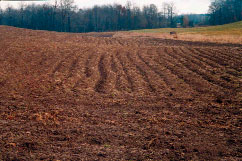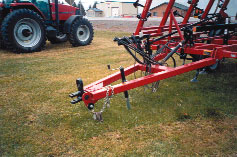Secondary
Tillage: Any room for improvement?
by Greg Stewart, OMAF Corn Specialist
|
|
Figure
1. Rough soils after chisel plowing
(twisted shovels) make efficient secondary tillage more challenging. |
One of the main
objectives of secondary tillage is to leave the seedbed as uniform as possible.
How can you expect the planter to give uniform spacing and uniform emergence
if the seedbed is not uniform? One of my particular hang-ups is with fall tillage
that leaves the field far too rough for secondary tillage to be able to smooth
it out in less than 2 or, in some cases, 3 passes. The twisted shovel chisel
plow is often the culprit and efforts should be taken to leave the soil more
uniform in the fall than is often the case with this tool. Remember that residue
cover on the soil surface is considerably more important than soil roughness
in preventing soil erosion. Achieving a more level profile may mean switching
to sweeps, a combination of shovels and sweeps, putting leveling devices on
the back of the chisel, or moving to some alternative form of primary tillage.
Leaving the soil rough in the fall also makes it more difficult to ensure that
the cultivator is not working the soil too deep - and consequently too wet -
in places.
Soil moistures that are too high at the time of cultivating can lead to a smearing
of the soil and may at times create horizontal zones of higher resistance to
root growth within the soil profile. Most producers are aware of the rule of
thumb for checking the suitability of soil for tillage. It consists of taking
a quantity of the soil and rolling it between your hands. If you can successfully
roll a cigar shape that is 1¼4 inch in diameter, the soil is too wet
to be worked. The point that bears repeating here is that if you are going to
work the soil 4 inches deep, then you need to dig down and test the soil moisture
at that depth.
Any field cultivator will do a better job if it is checked over carefully
this spring. At minimum, the list should include the following checkpoints:
• Replace worn teeth, broken springs.
• Adjust tongue height and/or fore/aft leveling to ensure the back and
front of the cultivator are running at the same depth.
• Ensure all tires are correctly inflated.
• Harrows should be running level with spring tension uniform across the
width of the equipment.
|
|
| Figure
2. Make the necessary equipment adjustments to allow you to perform uniform,
efficient and shallow secondary tillage. |
The desire to have
the field cultivator as finely tuned as possible should stem from the goal of
pulling the field cultivator rapidly, uniformly and as shallow as possible while
still creating a fine, firm seedbed. Any faults in the cultivator that don’t
get fixed before you head to the field often get compensated for by setting
it a bit deeper!
Most growers feel a need to cultivate deep enough to rip up the tire track.
Jack Wiley, former John Deere engineer, spoke at the South West Ag Conference
in January 2003 and made the point that planting corn into tire tracks is not
a problem provided that your inflation pressure is 16 PSI or less. Growers he
has worked with in the Corn Belt all seem to be getting along fine as long as
they keep the inflation pressure on the planter tractor below this 16 PSI benchmark.
The message probably applies to our cultivator tractors as well: run low inflation
pressures, stay off the soil when it is too wet and focus on creating a seedbed
(0 – 3 inches), not on ripping up tractor tracks.
Making a fine seedbed is the reason most growers run some sort of harrow and/or
packer as part of the secondary tillage operation. In years of tillage research,
seedbed fineness has been a reasonably good indicator of the potential yield
from a tillage system. From a dollars per acre perspective these devices are
probably a good investment. The only warning about seedbed fineness is centered
on the tilth or structure of your soil. Soils with low organic matter and poor
structure that are left with a very fine aggregate are more prone to crust.
The art of tillage in these situations is to strike a balance between seedbed
fineness and the risk of crusting while trying to improve soil structure over
time.
Back
to Top


